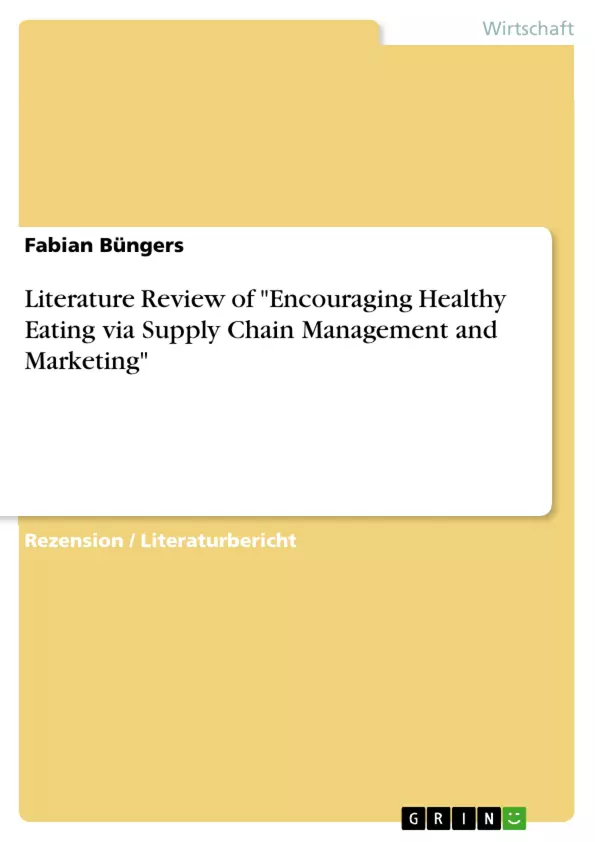The following literature review discusses the thesis: “Encouraging healthy eating via supply chain management and marketing“, which was stated by Yulia Tseytlin. The introduction illustrates the structure of this review and gives a brief overview about the content. The aim is enabling the reader to completely decode the chain of thoughts which is presented.
At first, the mentioned thesis is separated in individual parts: “healthy eating”, “supply chain management”, as well as “marketing”. All parts include a concise definition of the particular term, as well as a conclusion.
Within the part “healthy eating” (HE), the current situation will be illustrated by delivering diverse facts and figures. Furthermore, the question why HE is important will be discussed, as well as present factors influencing HE.
Inside “supply and chain management” (SCM), the present situation, linked to the food industry, is explained. Potential advantages of well-planned supply chains (SC) will be discussed, in addition, possible dangers of ineffective ones. Finally, a link to the module “healthy eating” will be created.
“Marketing” is the last part. The present significance of marketing within society, especially in the food industry, will be pointed out. Chances of influencing people in the organic food industry via marketing will be discussed. Likewise, this part will be connected to “healthy eating” as well as “supply and chain management”.
Secondly, the above mentioned parts are connected and ways of “encouraging healthy eating via supply and chain management” will be shown, based on the information provided in the individual modules. Those parts can be seen as a toolbox, which is necessary to create the final product: the analysis of different encouraging approaches.
Due to limitations concerning the length of this review, the different modules will be explained in a precise, but brief way. The main focus lies on the junction of the mentioned parts and the analysis of the stated thesis. Different literature sources have been used to underline mentioned facts.
Inhaltsverzeichnis (Table of Contents)
- 1. Einleitung
- 2. Gesundes Essen
- 2.1 Definition
- 2.2 Fakten und Zahlen
- 2.3 Warum gesundes Essen wichtig ist
- 2.4 Aktuelle Einflussfaktoren auf gesundes Essen
- 2.5 Fazit
- 3. Supply Chain Management
- 3.1 Definition
- 3.2 Aktuelle Situation im Zusammenhang mit der Lebensmittelindustrie
- 3.3 Vor- und Nachteile einer gut strukturierten Lieferkette
- 3.4 Verbindung zu gesundem Essen
- 3.5 Fazit
- 4. Marketing
- 4.1 Definition
- 4.2 Gegenwärtige Bedeutung
- 4.3 Marketing in der Bio-Lebensmittelindustrie
- 4.4 Verbindung zu gesundem Essen und Supply Chain Management
- 5. Verbindung aller Teile
- 5.1 Definition von "Fördern"
- 5.2 Warum gesundes Essen gefördert werden sollte
- 5.3 Möglichkeiten, gesundes Essen durch Supply Chain Management und Marketing zu fördern
- 6. Abschließendes Fazit
Zielsetzung und Themenschwerpunkte (Objectives and Key Themes)
Diese Literaturübersicht befasst sich mit der These "Gesundes Essen fördern durch Supply Chain Management und Marketing", die von Yulia Tseytlin aufgestellt wurde. Der Fokus liegt auf der Analyse von Strategien, die gesunde Ernährung durch ein effektives Management der Lieferkette und gezielte Marketingmaßnahmen fördern können. Dabei wird zunächst ein umfassendes Verständnis der einzelnen Bereiche – "Gesundes Essen", "Supply Chain Management" und "Marketing" – geschaffen. Anschliessend werden die Zusammenhänge zwischen diesen Bereichen beleuchtet und verschiedene Ansätze zur Förderung von gesundem Essen aufgezeigt.
- Definition und Bedeutung von gesundem Essen
- Aktuelle Herausforderungen und Trends in der Lebensmittelindustrie
- Die Rolle des Supply Chain Managements bei der Bereitstellung von gesunden Lebensmitteln
- Marketingstrategien zur Förderung von gesundem Essen
- Zusammenhänge zwischen Supply Chain Management, Marketing und gesundem Essen
Zusammenfassung der Kapitel (Chapter Summaries)
Das erste Kapitel führt in die Thematik der Literaturübersicht ein und erläutert die Struktur und den Inhalt der Arbeit. Das zweite Kapitel widmet sich der Definition von "Gesundem Essen" und beleuchtet die aktuelle Situation anhand von Fakten und Zahlen. Es werden auch die Ursachen und Folgen von ungesundem Essverhalten sowie wichtige Einflussfaktoren auf das Essverhalten erörtert. Das dritte Kapitel befasst sich mit dem "Supply Chain Management" und erläutert seine Bedeutung im Kontext der Lebensmittelindustrie. Es werden die Vorteile einer effizienten Lieferkette sowie die Gefahren von Ineffizienz untersucht. Im vierten Kapitel wird das "Marketing" im Zusammenhang mit gesundem Essen behandelt. Die Bedeutung des Marketings in der Lebensmittelindustrie, insbesondere in der Bio-Branche, wird beleuchtet. Das fünfte Kapitel zeigt die Verbindung zwischen den verschiedenen Bereichen und stellt Möglichkeiten zur Förderung von gesundem Essen durch Supply Chain Management und Marketing vor.
Schlüsselwörter (Keywords)
Gesundes Essen, Supply Chain Management, Marketing, Lebensmittelindustrie, Bio-Lebensmittel, Ernährungsverhalten, Lieferkette, Produktqualität, Verbraucherverhalten, Nachhaltigkeit, Effizienz, Gesundheitsförderung.
- Quote paper
- Fabian Büngers (Author), 2015, Literature Review of "Encouraging Healthy Eating via Supply Chain Management and Marketing", Munich, GRIN Verlag, https://www.grin.com/document/312940



